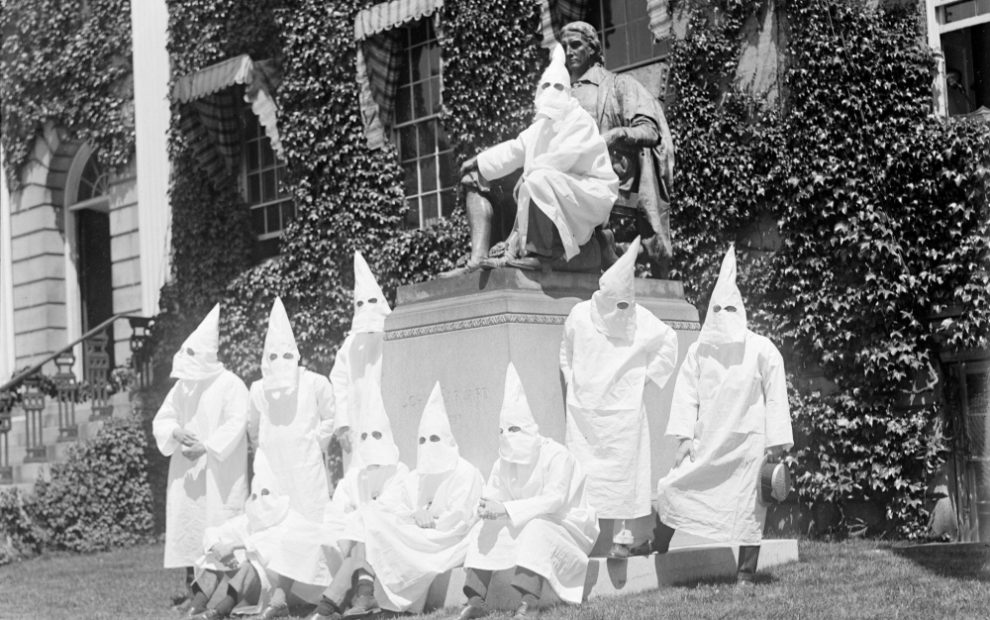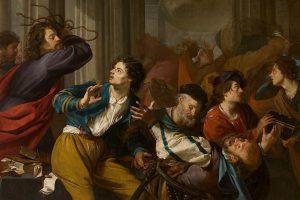The photograph, depicting robed and hooded KKK members gathered in a church, in front of a banner reading JESUS SAVES, is spiritually grotesque. And morally repugnant. So, as a theology teacher, of course I have been using it for almost 10 years.
The reason is as simple as it is important. The heresy of white supremacy, explicitly or implicitly, continues to mold countless individuals, groups, politicians, and institutions. It has left fingerprints all over contemporary society, politics, the church, and beyond. Although the photo is from the 1920s, it clearly depicts white supremacy for what it truly is: a Christian heresy grown in U.S. soil
Theology is supposed to communicate some saving and healing news to people from their God. In an increasingly racially diverse nation, the raising of consciousness about this evil, its persistence, and how to resist it in order to envision and create a more just world does indeed communicate some good news of salvation and healing for the troubled soul of a nation.
In the classroom, I begin the lesson here. Projecting the photo on a screen, I let students gaze upon it and process their reactions. Whether college, graduate, adult education, or teens, many students tend to be a bit shocked. Something in the photo just doesn’t compute for them. For others, it confirms their suspicions and experiences. For even others, it reminds them of the sick proximity of racism in their own churches’ histories, usually unacknowledged.
I say nothing for a few moments. I want them to have space for emotions. Then, I begin facilitating basic observations:
“Who are the people in the white-hooded costumes?” The Ku Klux Klan, a centuries-old white supremacist terrorist organization.
“Where are they?” In a church building of some kind.
“What does the sign above them read?” It reads, “Jesus saves.”
I stop. Then I ask again: “What does the sign above them read?” A hand goes up or a voice speaks out, “Jesus saves.”
Then, to be certain that the point hits home, I ask: “Is this a real photo, and are they being serious?” The students think for a moment. Then a hand goes up or a voice responds, “Yes, it is real. And yes, they are serious.”
I pause and let that sink in. I take a few breaths, then I continue, “What is the message they are trying to communicate?” A cacophony of hands and voices coalesce over the next few minutes, and the students arrive at a response along these lines: These people think Jesus was a white man and is the savior only for white people. They think that Christianity is only a white man’s religion and that Black people and other people of color are inferior, separated from God, and beyond redemption.
Now, we are getting somewhere. I continue, “And are they correct? Is the religion of Jesus compatible with white supremacy?” Of course, the students say no. Or better yet, “Hell no, Dr. C!”
They are correct. But it’s time to move into a deeper analysis. White supremacy encompasses more than just some guys in white hoods. It encompasses entire patterns of thought, often subconscious; habits of action, often which seem “normal”; and ways of understanding and organizing the world that denigrate anyone who does not fully conform to the idea of “whiteness.”
I look out at my students who represent an improbably diverse cross-section of racialized peoples in the United States. I need to push them further. “Yes! Of course, you are correct. But, really, how do you know? What makes you so certain? These people in the photo think they are all disciples of Christ. They go to church, they pray, they worship. Then, they carry out lynchings and other horrible crimes against Black people, other people of color, and other communities that diverge from their deranged ideal of what theologian Kelly Brown Douglas calls ‘white Anglo-Saxon Protestant exceptionalism.’ ”
I continue: “So, how is the fact represented by this photo possible? How can a person be both a disciple of Jesus and a violent terrorist who worships at the altar of white supremacy?” The students usually agree, after some conversation and debate about exactly how to word it, that the two cannot go together. The Way of Jesus is incompatible with the way of white supremacy.
Nodding my head, I let them know that finally we have come to the core of the problem. And I write a word on the board, “heresy,” and tell them to write it down and look up its meaning. Often, the Merriam-Webster Dictionary is where they find a working definition: (a) adherence to a religious opinion contrary to church dogma, (b) denial of a revealed truth by a baptized member of the Roman Catholic Church, and (c) an opinion or doctrine contrary to church dogma.
I tell them that this definition is not necessarily incorrect—but it is incomplete, at least from a theological perspective. This indeed is the meaning of heresy that has been passed onto us from medieval Europe, the later European Reformation and its “wars of religion,” and the response of the European Enlightenment that, generally speaking, called for the human person to place greater trust in the power of reason exercised by the individual rather than in any authority that claims divine knowledge that is fully beyond interrogation by human reason.
I now begin to collect the pieces and put them together for the students to analyze. I remind them that although the textbook and the dictionary define “heresy” as an “unorthodox belief” or “doctrine incompatible with Christianity,” it is more than that. It is when religion goes horribly wrong, great harm is committed, blood is spilled, and human life is destroyed, all in the name of God. It is not just wrong thinking or wrong belief, or even honest questioning. No, heresy in its deeper sense means when religion has gone so wrong in doctrine, belief, and practice that others are actively harmed by the “normal” practice of that religion. Jesus’ example of loving God, loving your neighbor, and loving your enemy—which he calls his disciples to imitate—is eclipsed by something else entirely. And that something else is not of God. It is not so much a question of orthodoxy—right intellectual belief—but orthopraxis—right relationship of doctrine, belief, actions, lifestyle, and spirituality that manifests in authentic discipleship to Christ.
Writer and critic James Baldwin famously critiqued much of white Christianity on these very grounds by saying, “I can’t believe what you say because I see what you do.” The words of priests, pastors, missionaries, and believers sounded as sweet as honey and promised something that seemed too good to be true: a taste of heaven on earth, God’s in-breaking kingdom here and now. But their actions showed what they truly believed. And many of these actions were soaked in violence, oppression, arrogance, supremacy, idolatry, and allegiance to unjust and ungodly systems of power and control.
I then bring up another phrase that many students have heard: “anti-Christ.” I tell them that although a character associated with this word appears in the Book of Revelation, there is more to it. “Anti” simply means “against” or “in opposition to.” “Christ” in the Christian tradition points toward God’s Messiah, Jesus, in whom God uniquely dwelt and who revealed God to us. And I connect this term to “heresy.” We can identify heresy through taking Baldwin’s critique seriously and thinking about the literal meaning of “anti-Christ.” A heresy is a sickness in a Christian community that leads its members to engaging in a way of life that is against anything and everything that Christ stood for, lived for, died for, and was resurrected for. A heretical way of believing, worshipping, and living inflicts great physical, mental, and spiritual harm onto others while thinking itself justified in doing so. In other words, a religious way of life that harms others is “anti-Christ” or the complete antithesis of the Way that Christ taught and lived.
Now I can emphasize the main takeaway from the lesson: With these understandings in mind, white supremacy is a contemporary heresy, like the dualistic Gnostics from the ancient world. I remind the students that this is not my own invention. Prophets like the Rev. Dr. Martin Luther King Jr. wondered whether Black people and white people actually worshipped the same God. Black theologians, such as the late Rev. Dr. James H. Cone, used this very reasoning to level the charge of heresy against many white theologians and white-dominated churches decades ago. The charge has never been resolved, and the wounds have never healed.
I finish and summarize the lesson. White supremacy is a Christian heresy. Roman Catholics are one part of the ecumenical global Christian community. So, Roman Catholics too must struggle against this heresy for the sake of Christ and the world. One way to combat this heresy is to ensure Catholic schools, specifically theology classes, learn how the work of Jesus Christ connects in many ways with the work of anti-racism. That is, learning to participate in God’s work of eradicating racism and transfiguring this evil—a privation of the good—into something that no longer destroys life but midwifes new life. And life abundant.
Too many white Christians do not seem comfortable recognizing and accepting the fact that this evil did not just magically disappear with the civil rights movement. And neither was it confined to just one moment in history. So, more than a decade ago, it became imperative for me to weave the sick persistence of the heresy of white supremacy into my theology classes. And having students examine this photo proved to be a useful introductory exercise.
After all, the photo is real. And in all of its moral repugnance and spiritual grotesquerie, its existence as a Christian heresy that actively harms others has assisted in making anti-Black racism “normal” in much of church and society. That is a fact. You see, the hoods and costumes are not required for the heresy to live on, the harms to continue to be inflicted, and the wounds of racial injustice to remain open and festering. All that is needed is to remain a stiff-necked people who can no longer differentiate between what is and what is not of God’s Spirit.
But scripture is saturated with God’s stern and loving call to repentance for God’s stiff-necked people. For those of us racialized as “white,” the work God calls us to is distinct. It requires learning about history and how our families fit into that history. It requires a commitment to make a better present and future for all peoples. It also requires prayer, usually contemplative prayer, to allow God’s Spirit to heal our psyches and souls, along with participation in a community committed to humbly and mercifully walking an anti-racist path together. This is the beginning of a way of healing. It requires cultivating new habits that may have been denied due to the persistence of racial segregation, namely to learn respectful deference to the voices and leadership of people of color before trying to push back with our own thoughts and ideas.
In this way, we may truly experience and believe that we too are God’s beloved regardless of the melanin content in our skin. That correlation between melanin content and the capacity to manifest the imago dei (image of God) that has been passed down to us as the social construct of “race” has led to the lifting up of some bodies—light-skinned bodies—as more Godlike than others. And it is one that needs to be severed and opened up to God’s Spirit for healing and the creation of a new future—one of the Beloved Community in which the hierarchy of racialization is dismantled and transfigured into something new.
The challenge is mind-boggling. But my students give me hope. After class is over, more than a few stick around. They want to work on an assignment to connect faith with anti-racism. They are interested in this method of living the Way of Jesus in the 21st century.















Add comment